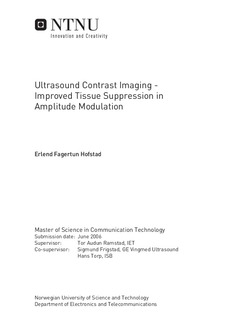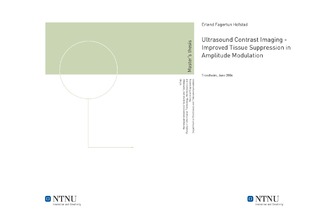| dc.description.abstract | The ability to image myocardial perfusion is very important in order to detect coronary diseases. GE Vingmed Ultrasound uses contrast agent in combination with a pulse inversion (PI) technique to do the imaging. But this technique does not function sufficiently for all patients. Therefore have other techniques been tested out, including transmission of pulses with different amplitude (AM), to enhance the nonlinear signal from contrast bubbles. But a problem achieving sufficient cancellation of linear tissue signal is a feebleness of the method.
In this diploma work has an effort been put into enhancing the tissue suppression in amplitude modulation. First the source of the lack of suppression was searched for by measuring electrical and acoustical pulses. The further examination revealed a dissymmetry in between pulses of different amplitude. To reduce this error were several attempts to make a compensation filter performed, which finally resulted in a filter created of echo data acquired from a tissue mimicking phantom. The filter was furthermore tested out on a flow phantom to see how it affected the signal from tissue and contrast bubbles, compared to the former use of a constant instead of the filter. The comparison showed 1.5-3.2 dB increase in tissue suppression (TS). But unfortunately did the filtering process slightly reduce the contrast signal as well, which resulted in a smaller increase of Contrast-to-Tissue-Ratio (CTR) than TS; 1.0-2.8 dB.
During the work was the source of another problem concerning tissue suppression discovered. In earlier work by the author \cite{prosjekt} the experimental results suffered from low TS around the transmitted frequency, which was found inexplicable at that time. This problem was revealed to be caused by reverberations from one pulse, interfering with the echoes from the next pulse. The solution suggested in this thesis is to transmit pulses in such a way that every pulse used to create an image has a relatively equal pulse in front. For instance, if a technique employs two pulses to create an image, and the first has half the amplitude and opposite polarity of the second. Then, to eliminate the reverberations must the first imaging pulse have a pulse in front which has half the amplitude and opposite polarity of the pulse in front of the second imaging pulse. | |

